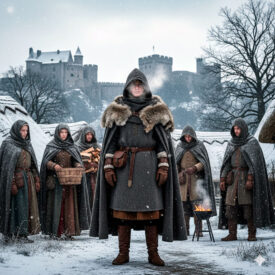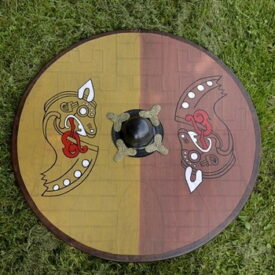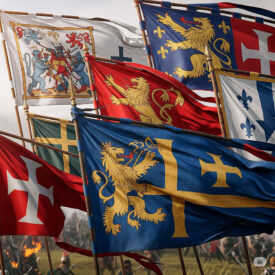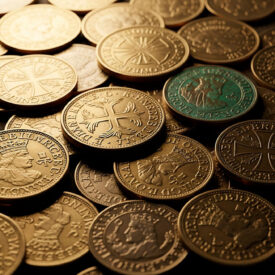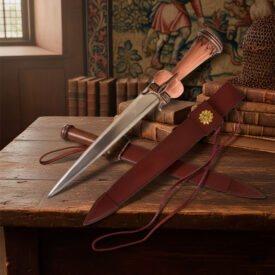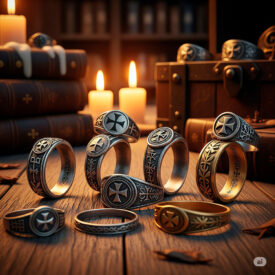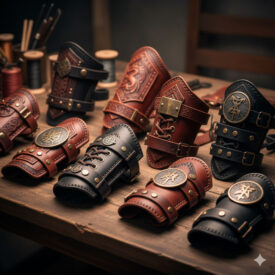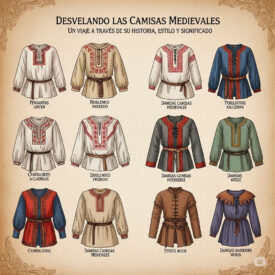What does an ancient tendril whisper when it sways in the medieval wind? The word pendiente (earring) comes from the Latin pendens, pendentis, meaning something that hangs, that is suspended; this same term gave its name to the earring, tendril, or hoop that since ancient times has served to adorn the ears and to communicate social position, devotion, and aesthetic taste.
In this article, you will explore what medieval earrings were like, what materials and techniques marked their evolution, and what symbols they bore, from the Byzantine court to the artisan workshops of the Late Middle Ages. You will also find a visual timeline that highlights the key milestones of their use.
Ear Ornaments in the Middle Ages: Evolution and Milestones
The history of earrings in the Middle Ages is not linear: there are times of ostentation and others when headdresses concealed the jewel. The following table shows, in chronological order, the main milestones and trends in the use of earrings (and other ear ornaments) from late antiquity to the transition to the Renaissance, according to the available sources.
| Era | Event |
|---|---|
| Byzantine Empire (4th–15th centuries) | |
| 4th–15th centuries | Men and women wore large hoops, often adorned with Christian motifs such as crosses. The Byzantine tradition maintained some continuity in the use of ostentatious earrings. |
| Early Middle Ages and General Fashion (c. 500–c. 1200) | |
| c. 500–c. 1200 |
|
| High and Late Middle Ages: Rise and Diversity of Forms (12th–15th centuries) | |
| 12th–15th centuries |
|
| Hispanic Islamic Context — Nasrid Málaga / Granada (13th–15th centuries) | |
| 13th–15th centuries | In the Muslim necropolis of the Hospital Real next to the Puerta Elvira (Granada), earrings, beads, and other luxury objects have been documented, evidencing the presence and variety of ear ornaments in Nasrid contexts. |
| Transition to the Renaissance (15th–16th centuries) | |
| 15th–16th centuries |
|
| Summary | |
| Function and Meaning | Although medieval fashion and headdresses reduced their daily visibility, earrings remained ornamental jewels of high value, an indicator of status and, occasionally, used for communicative purposes in courtship. Their form and wear varied greatly according to region, class, and era. |
Materials and Techniques: From Gold to Filigree
Medieval earrings reflect the economic hierarchy and technical capabilities of their time. In the nobility, gold and silver predominated, set with garnets, amethysts, pearls, and enamels. Among common people, bronze, copper, iron, and organic materials such as bone, wood, or ivory were used.
The techniques that dominated the workshops were filigree, granulation, enamel, casting, and setting. These practices allowed for everything from simple pieces to complex pendants with chains, pearls, and symbolic motifs.
Visual Examples and Motifs
Religious and heraldic motifs frequently appear in high-value pieces; one of the recurring icons in replicas and studies are Templar crosses and designs inspired by medieval Christian symbolism.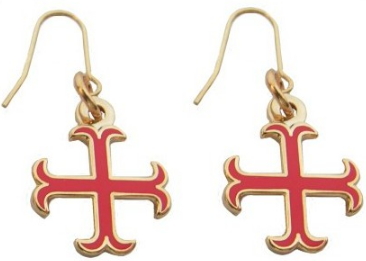
Not all pieces were symmetrical or monotonous: jewelry could incorporate amulets, enameled glass beads, or even distant cultural references that arrived via trade routes.
How to Read a Medieval Earring: Form, Function, and Message
An earring is not just an adornment: its size, material, and decoration tell a story. Observe these three axes to interpret a piece:
- Material: gold and pearls often indicate wealth and access to trade networks.
- Form: simple hoops vs. complex pendants; long pendants suggest exhibition at events and courtships.
- Motif: crosses, religious motifs, or heraldic symbols speak of identity and affiliation.
By way of illustration, some recreation pieces blend literary and fantastic influences with historical elements, as seen in replicas with motifs inspired by epic tales.
Replicas and Designs Inspired by the Middle Ages
Today, the enthusiasm for historical reenactment and medieval aesthetics has encouraged the creation of replicas that recreate ancient techniques and forms. These pieces seek to capture the essence of the originals: apparent materials, symbolic motifs, and finishes that evoke the manual work of the goldsmith.
Clearing Up Doubts About Medieval Earrings
| Oil Type | Key Characteristics | Recommended Use |
|---|---|---|
| Mineral Oil | High penetration, does not degrade or attract dirt | Regular protection and maintenance |
| Camellia Oil | Natural, acid-free, non-volatile | Antioxidant protection, lubrication |
| Lithium Grease | Dense, durable, does not evaporate | Extended storage, protection |
What were the most common materials used to make earrings in the Middle Ages?
The most common materials used to make earrings in the Middle Ages were primarily gold, silver, bronze, and iron. Additionally, precious and semi-precious stones such as garnets, amethysts, amber, emeralds, and sapphires, as well as pearls and enameled glass, were incorporated to decorate the pieces. Techniques such as embossing, engraving, and granulation were also used to work these metals and create elaborate jewelry, especially for nobility and royalty, while simpler materials like bronze and iron were used among the common classes. Other less common materials included wood and bone for simpler jewelry.
What did medieval earrings symbolize in terms of social status?
 Medieval earrings symbolized social status and belonging to a specific group, being a visible indicator of wealth and position within the social hierarchy. In particular, those who wore earrings made of elaborate materials and designs usually belonged to the nobility or upper classes, while some men also wore them as a symbol of status or social affiliation. The quality, type, and complexity of the jewelry —including earrings— reflected the wearer’s social position and were regulated by social norms and codified in dress ordinances.
Medieval earrings symbolized social status and belonging to a specific group, being a visible indicator of wealth and position within the social hierarchy. In particular, those who wore earrings made of elaborate materials and designs usually belonged to the nobility or upper classes, while some men also wore them as a symbol of status or social affiliation. The quality, type, and complexity of the jewelry —including earrings— reflected the wearer’s social position and were regulated by social norms and codified in dress ordinances.
How did the artistic trends of the era influence earring design?
Artistic trends influenced earring design mainly through the incorporation of formal and conceptual elements characteristic of each artistic movement, such as the geometric forms of Cubism or the use of bold colors and textures of Expressionism and Fauvism. This resulted in earrings that could range from minimalist and innovative to large, showy, and visually impactful, bringing jewelry closer to being considered a portable art form that reflects emotions, stories, and creativity beyond mere ornamentation.
For example, the geometry and angularity of Cubism inspired earrings with fragmented lines and combined planes, while Expressionist currents brought intense color and textures that sought to provoke emotions. Furthermore, the current trend towards sustainable materials and artisanal designs also responds to a contemporary artistic consciousness that values both the aesthetics and the environmental and social message of each piece.
In summary, artistic currents shaped earrings by influencing their forms, colors, techniques, and materials, making these jewels creative expressions that reflect the cultural and artistic context of their era.
What differences existed between the earrings of the noble classes and the lower classes?
 The differences between the earrings of the noble classes and the lower classes lay mainly in the materials, design, and symbolism. Noble earrings were usually made of precious metals such as gold and silver, adorned with fine jewels or stones, displaying wealth, social status, and power. In contrast, the earrings of the lower classes were generally made of common and less expensive materials, with simpler or even improvised designs, reflecting their limited access to resources and their inferior social position.
The differences between the earrings of the noble classes and the lower classes lay mainly in the materials, design, and symbolism. Noble earrings were usually made of precious metals such as gold and silver, adorned with fine jewels or stones, displaying wealth, social status, and power. In contrast, the earrings of the lower classes were generally made of common and less expensive materials, with simpler or even improvised designs, reflecting their limited access to resources and their inferior social position.
What jewelry techniques were developed during the Middle Ages to create earrings?
During the Middle Ages, several jewelry techniques were developed to create earrings, among which stand out:
- Forging: shaping metal by hammering and bending to form pieces.
- Casting: heating and pouring metal into molds to obtain complex shapes.
- Filigree: intertwining fine gold or silver threads to design detailed and decorative patterns.
- Setting: precise placement of precious stones in metal mounts to secure and enhance their beauty.
- Enameling: application of colored glass powder onto metal that is heated to create a decorative and shiny surface.
- Cloisonné: creation of cells with metal threads filled with stones or enamel for decoration.
These techniques combined manual skills of precision and patience and were used to manufacture pieces ranging from earrings to brooches and pendants, primarily using gold, silver, and precious stones. Goldsmithing work was very elaborate, especially for complex or high-value symbolic jewelry. Additionally, repoussé methods and other decorative details were used to embellish medieval jewelry.
Key pieces to remember:
| Type | Frequent Material | Function |
|---|---|---|
| Simple Hoops | Bronze, Copper | Daily wear, accessible to common classes |
| Dangle Earrings with Pearls | Silver, Gold, Pearls | Exhibition in courtship and ceremonies |
| Earrings with Religious Motifs | Gold, Enamel | Expression of devotion and status |
The last word: Medieval earrings are small stories in metal and stone. Each hoop and each pendant condense technique, material journey, and social codes. Observing them carefully allows us to read the society that created them and to better understand the customs, tastes, and beliefs of an era that, through its jewelry, still speaks.

